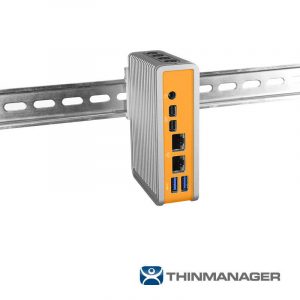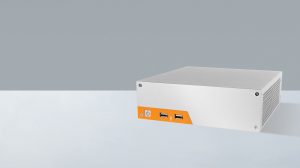What is a Zero Client?
Thick Clients, Thin Clients, and Zero Clients – What’s the Difference?
When we talk about clients in technology, be it thick, thin, or zero, we are referring to computers. A processor, some memory, and a connection to a few peripherals like a mouse, keyboard, and monitor are their similar features. Their differences however, are also their distinctions.
What is a Thick Client?
You can think of a thick (also referred to as a heavy or fat) client as essentially a traditional computer. It has a storage drive with an operating system and applications installed directly onto it. Thick clients can operate without dependencies on external resources, with everything loaded from the local storage drive inside the system. This means you can use it even if you unplug the ethernet cable or turn off the Wi-Fi.
What is a Thin Client?
A thin client is a computer with minimal local storage. It is designed to deliver programs and applications to the user from a centrally located terminal server. Thin clients often still host a minimal operating system and store configuration settings in flash memory. However, the majority of data and applications utilized by the end user are not stored directly on the thin client.
Instead, thin clients connect to a central server on boot. They rely on that server to provide users with the necessary software applications and data. This means the computer acts as a terminal to facilitate the connection. The user sees and works within their applications run by the server.
What is a Zero Client?
A zero client is a computer with no local storage – rather it relies on a connection to a local server. When a zero client turns on, it uses firmware to boot off of the network and connect to the server. Then it downloads what it needs directly into memory rather than onto a hard drive.
Zero clients do not retain an operating system nor any configuration settings. In fact, it is entirely up to the server to identify the computer and decide what content to serve to the user. IT administrators determine what the server “serves” to the zero client.
Common aspects of a zero client include:
- Low power usage
- Reduced cost
- Easy administration
- Limited ability to render graphics
- Complete dependence on network connection.
As the name implies, a zero client takes the concept of thin client one step further. Or, one step thinner.
ThinManager Software Enables True Zero Clients
For a computer to function as a zero client, it requires a terminal server equipped with software such as ThinManager. ThinManager enables end-user computers to be true zero clients. The software uses network boot and remote desktop services to deliver applications and other content to end-user devices.
A common application for this would be in a smart factory. You can deliver workstations to end-users without having to provision hundreds of thick clients. Managing resources centrally also means you can tailor the applications served to specific shifts or times.
ThinManager provides a dashboard that allows administrators to manage connections between the terminal server and zero client computers, mobile devices, and IP cameras. All of this can be done without writing any code. It offers an easy to integrate solution ready for any industry and allows for terminal server and zero (or thin) client management that is easy to set up and maintain.
The Benefits of Zero Clients
Where do we use zero clients? Oftentimes, zero clients will be used in a virtual desktop environment (VDI) or in a distributed work environment, like in a smart factory. The main benefits of zero clients can be summed up in three words: efficiency, effectiveness, and security.
Without a storage drive, you cannot install, delete, or change anything on the zero client itself. Everything lives on the server. This ensures that only certain users have access to data. And with no software on the device, there is low risk of vulnerability to malware.
Zero clients do no retain data on the device, like, when you power it down or remove it from the network. So if bad actors gain access to the physical hardware, they are unable to harvest valuable data directly from the device.
The Benefits of Zero Clients and ThinManager Software
ThinManager’s software offers advanced control and security features including: auto power on, shadowing, MultiSession, dual display, and failover support. In addition, it is integratable with Citrix, VMware and Microsoft Active Directory.
ThinManager has the flexibility to deliver the content and applications to the intended employee at the precise location and time of their choosing. This mobility feature enables you to leave your desk, move from client to client, and have the content and applications required, exactly where you need it.
Zero Client with Thin Manager Example
Imagine a line manager of an automotive manufacturer sitting at a desk in their office. They notice an irregularity on the shopfloor and want to assess the situation on site. With ThinManager, they can access that exact data they were viewing from their desk via a tablet stationed on the factory floor.
When the issue is resolved, they can put the tablet back and know that the information is secure. And if the tablet is taken off site, data is not saved onto the device to potentially fall into the wrong hands. This removes an avenue for the mishandling of critical data.
Industrial Zero Clients at OnLogic
At OnLogic, we have partnered with ThinManager to offer a number of reliable industrial zero client systems for applications across industries. These ThinManager ready devices are shipped with a pre-configured BIOS to connect to ThinManager out of the box and are engineered to thrive in extreme environments.
Let’s take a look at two solutions that provide value for different use cases. First, the small and fanless TM110. Second, the powerful and flexible TM800.
TM110 Ultra Small Fanless Edge Computer
We’ll start from the outside and work our way in. The TM110’s industrial-grade hardshell fanless technology protects the system from dust, debris, chemical, and moisture ingress. It is ready to find its home on your factory floor. Its unique cast aluminum chassis dissipates heat while allowing for space-saving mounting options. It can withstand your tough environment.
The sides of the system are fully utilized for I/O. And even with its impressive compactness, the TM110 has the level of expansion found on larger boards, with additional options for storage. Pairing an x86 architecture with the Pico-ITX form factor makes for an ultra compact and reliable industrial computer.
This industrial zero client comes pre-configured for ThinManager, creating an energy efficient, ultra reliable, ultra small, fanless virtualization solution.
TM800 Industrial Mini-ITX Computer
Next, we have the TM800, an industrial zero client designed for reliability in embedded applications, complete with an all-metal chassis. Its double right angle folds reduce electromagnetic interference (EMI) and improve electromagnetic compatibility (EMC) performance. Equipped with a fan, the cross-case ventilation minimizes any fan noise. Ultimate flexibility is provided with mounting options for both vertical and horizontal installations.
The TM800 industrial zero client is a cost-effective and powerful device, capable of driving four independent displays. Multiple displays are particularly valuable for control rooms or other scenarios where you require visibility over multiple simultaneous processes. Quality and reliability are key to the TM800, with extensive I/O and robust expansion capabilities. This allows for high quality and reliable connections in both an industrial or an office setting.
More about ThinManager Industrial Thin Clients
Explore all of our ThinManager thin clients engineered for your industrial applications.
Get the Latest Tech Updates
Subscribe to our newsletters to get updates from OnLogic delivered straight to your inbox. News and insights from our team of experts are just a click away. Hit the button to head to our subscription page.
Share
More Articles
OnLogic Industrial Computers
Discover OnLogic's multitude of industrial computers that will help you to advance your IoT project
Learn more at OnLogic.com
OnLogic Industrial PCs: Designed to last. Built to order. Delivered in days. Visit our online store at OnLogic.com







